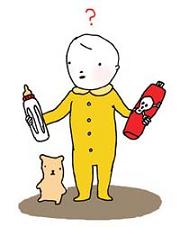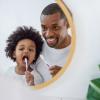 Here’s a scary scenario: Your toddler downs some prescription Tylenol — with codeine — then brings you the package. That’s just what happened to Montlake mom Lisa Erlanger recently. But Erlanger is a doctor, and quickly sized up the danger. Her 2-year-old daughter, Emma, had not taken enough to cause her harm. A relieved and grateful Erlanger used the scare as an opportunity to teach Emma about safe use of medicine — and to better child-proof her home.
Here’s a scary scenario: Your toddler downs some prescription Tylenol — with codeine — then brings you the package. That’s just what happened to Montlake mom Lisa Erlanger recently. But Erlanger is a doctor, and quickly sized up the danger. Her 2-year-old daughter, Emma, had not taken enough to cause her harm. A relieved and grateful Erlanger used the scare as an opportunity to teach Emma about safe use of medicine — and to better child-proof her home.
Sadly, this scenario is not uncommon. The Washington Poison Center (WPC) fields almost 100,000 phone calls a year about potential poisonings. Poisonings are the fifth-leading cause of accidental deaths in children younger than the age of 6. The most common sources of child poisonings? According to Kerri Booth, education coordinator for WPC, they are cosmetics and personal care items, cleaning and household items, and pain killers.
Cosmetics and personal care items
Children often get these items from an older child, or by finding the item in a purse or suitcase. “It doesn’t matter if they are boys or girls,” says Booth, “poisoning rates are about the same.” Parents should encourage everyone, including guests, to keep cosmetics and purses away from children, and children should never be allowed to play with personal care items. Ingestion of diaper creams and ointments is the leading reason for calls to the WPC for small children.
Cleaning and household items
As a mother, Booth chooses not to store cleaning supplies in cabinets under the sink. “If under the sink is really the best way to keep cleaning supplies away from food, that’s fine,” Booth says, “but you need a good lock.” She recommends that all poisons be locked and out of reach of children. And don’t assume your child is “old enough to know better” when it comes to cleaning products. Forty-three percent of calls to the WPC are about children younger than 5. That means that more than half of the calls are for people who are older.
Pharmaceuticals
Many poisonings occur when children find and eat pharmaceuticals not intended for them. But even more often, pharmaceutical poisoning occurs when a caregiver accidentally overdoses a child or gives the child the wrong medicine.
“Always designate one person as the administrator of medication,” advises Booth. Often, mistakes occur when one parent thinks a child hasn’t had her medication yet, and accidentally double-doses the child. Other times, bleary-eyed parents wake in the deep of night and don’t turn on the light or put on glasses, leading to an accidental overdose or a dose of the wrong medicine.
Treat medications just like other hazardous products: Lock them up and keep them out of reach. “Always use child-resistant lids,” advises Booth, “but don’t rely on them. A 3-year-old can open one in 3-5 minutes.”
And remember that visitors may bring dangerous medications into your house. As with cosmetics, give visitors a secure place to store medications so that children don’t find them in a suitcase, purse or on the counter in the guest bathroom.
Plants
More than 60 common toxic plants make gardens and parks potentially dangerous places. Lisa Taylor, Seattle Tilth Children’s Garden coordinator, teaches children and parents about plant safety. “Kids have to ask an adult who knows before picking and eating,” she says. “It’s a simple rule for everyone to remember.”
While the list of toxic plants is long, Taylor says that gardens where children play must omit only the most toxic four: foxglove, aconite, delphinium and columbine. And kids can learn about all plants, even those they should not touch. “The idea is to help them gain mastery of what’s OK and what’s not in the garden,” says Taylor.
Lead
Lead poisoning commonly occurs through inhaling or consuming lead-containing particles, in paint, soil or water. Lead can also be found in contaminated toys, cosmetics, candle wicks, pottery glaze, contaminated supplements, automobile batteries, vinyl mini-blinds, canned food with lead-soldered seams, or hobby and craft items, according to Molly Gray, N.D., L.M., from Seattle Natural Family Medicine.
While the WPC confirms that most children will not have suffered from lead poisoning as a result of common play with the recently recalled lead-tainted toys, lead is highly toxic and to be taken very seriously. “Lead alters very basic nervous system functions,” says Dr. Gray. Lead damages the central nervous system, which can manifest in a variety of ways, including inattentiveness, hyperactivity, headaches, abdominal pain, loss of appetite, constipation, clumsiness, agitation or decreased activity. If you’re in doubt, your child’s doctor can test for lead exposure.
Continual vigilance
Vigilance is the key to poison prevention. “On any given day, a child under 5 will put more non-food items into her mouth than she will food,” says Booth. If you’re ever concerned about a potential poisoning, the WPC is there, 24 hours a day, seven days a week. Booth encourages all parents to call. “There is no need to worry any longer than it takes to make a free phone call.”
Tera Schreiber is a freelance writer and mother from Seattle.
Resources
• Washington Poison Center: 1-800-222-1222, www.wapc.org
• Washington Poison Center’s “Poisons Around the Home” checklist: www.wapc.org/pdf/education/Checklist.pdf (PDF)
• U.S. Environmental Protection Agency’s Safe Drinking Water Hotline: 1-800-426-4791
• National Lead Information Center: 1-800-424-LEAD
• Office of Healthy Homes and Lead Hazard Control: www.hud.gov/offices/lead
• Seattle Tilth — Educates adults and children on plants and plant safety through various programs, including a Children’s Garden program: www.seattletilth.org
• American Lung Association’s Master Home Environmentalist Program — Trains people to assess houses for environmental contaminants. Contact the ALA-MHE program to sign up for training or to request a home assessment. 206-441-5100, www.alaw.org/air_quality/master_home_environmentalist











